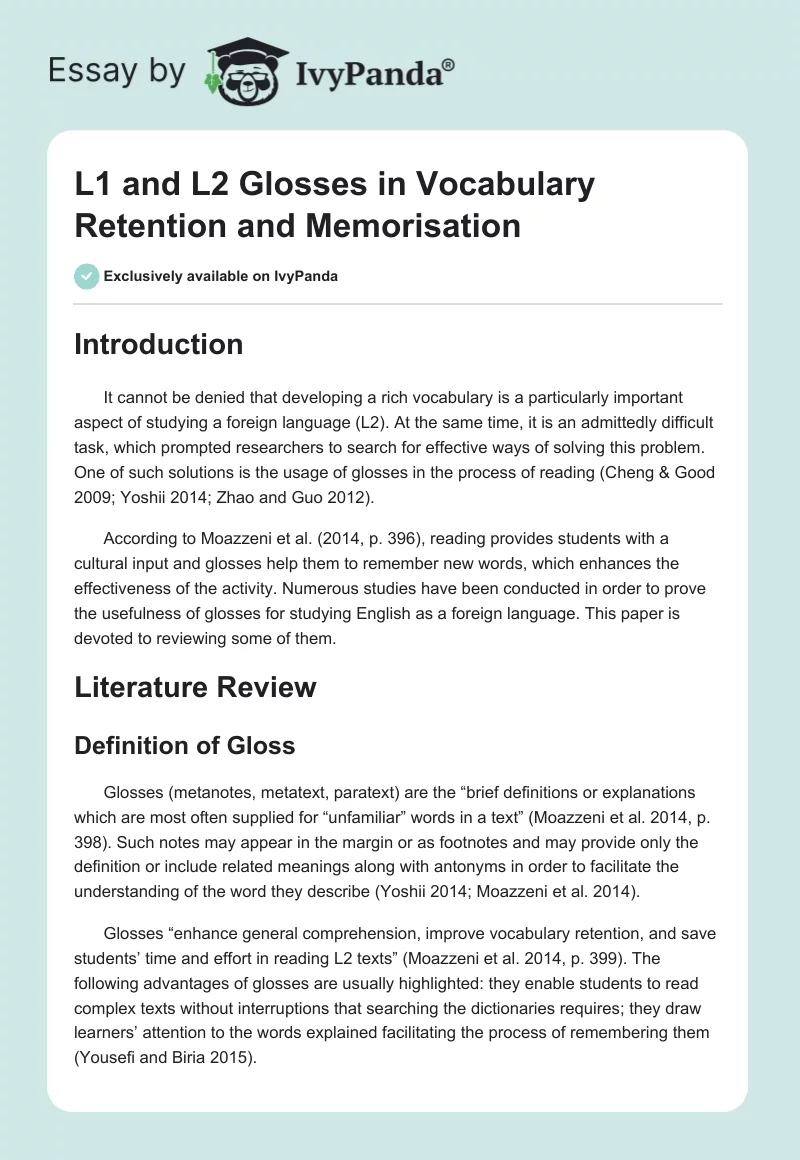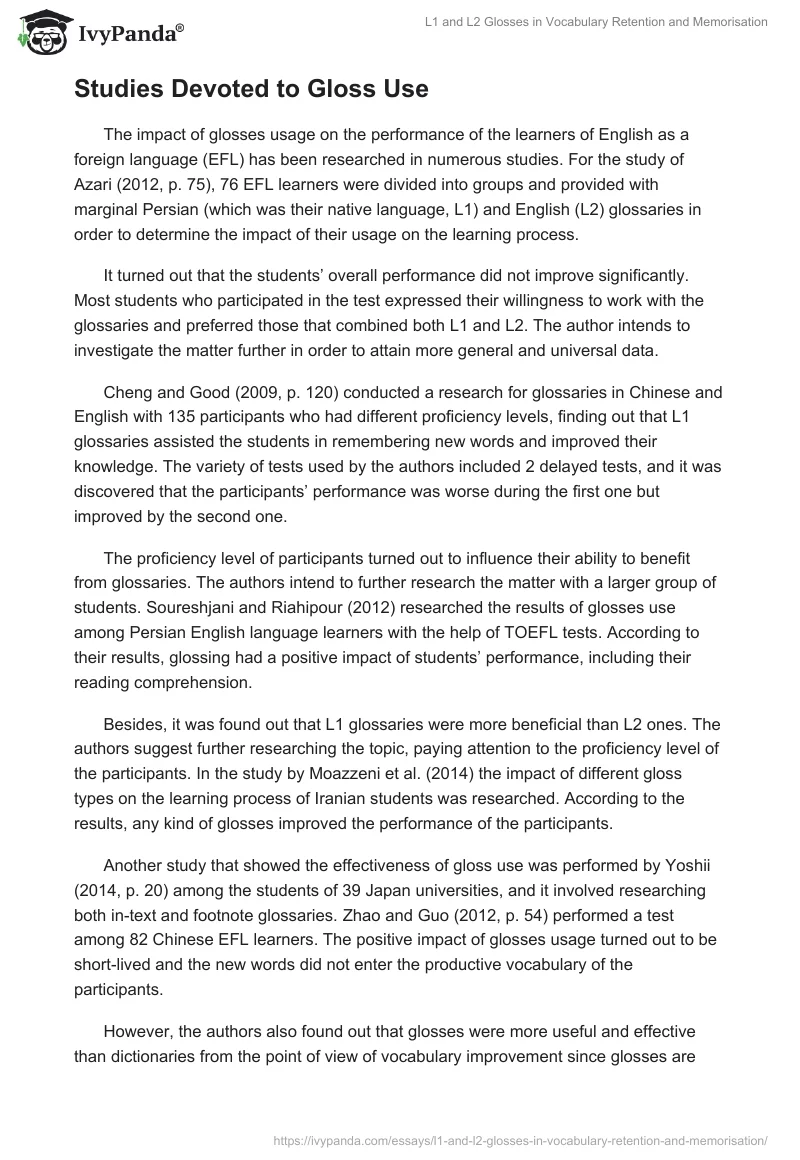Introduction
It cannot be denied that developing a rich vocabulary is a particularly important aspect of studying a foreign language (L2). At the same time, it is an admittedly difficult task, which prompted researchers to search for effective ways of solving this problem. One of such solutions is the usage of glosses in the process of reading (Cheng & Good 2009; Yoshii 2014; Zhao and Guo 2012).
According to Moazzeni et al. (2014, p. 396), reading provides students with a cultural input and glosses help them to remember new words, which enhances the effectiveness of the activity. Numerous studies have been conducted in order to prove the usefulness of glosses for studying English as a foreign language. This paper is devoted to reviewing some of them.
Literature Review
Definition of Gloss
Glosses (metanotes, metatext, paratext) are the “brief definitions or explanations which are most often supplied for “unfamiliar” words in a text” (Moazzeni et al. 2014, p. 398). Such notes may appear in the margin or as footnotes and may provide only the definition or include related meanings along with antonyms in order to facilitate the understanding of the word they describe (Yoshii 2014; Moazzeni et al. 2014).
Glosses “enhance general comprehension, improve vocabulary retention, and save students’ time and effort in reading L2 texts” (Moazzeni et al. 2014, p. 399). The following advantages of glosses are usually highlighted: they enable students to read complex texts without interruptions that searching the dictionaries requires; they draw learners’ attention to the words explained facilitating the process of remembering them (Yousefi and Biria 2015).
Studies Devoted to Gloss Use
The impact of glosses usage on the performance of the learners of English as a foreign language (EFL) has been researched in numerous studies. For the study of Azari (2012, p. 75), 76 EFL learners were divided into groups and provided with marginal Persian (which was their native language, L1) and English (L2) glossaries in order to determine the impact of their usage on the learning process.
It turned out that the students’ overall performance did not improve significantly. Most students who participated in the test expressed their willingness to work with the glossaries and preferred those that combined both L1 and L2. The author intends to investigate the matter further in order to attain more general and universal data.
Cheng and Good (2009, p. 120) conducted a research for glossaries in Chinese and English with 135 participants who had different proficiency levels, finding out that L1 glossaries assisted the students in remembering new words and improved their knowledge. The variety of tests used by the authors included 2 delayed tests, and it was discovered that the participants’ performance was worse during the first one but improved by the second one.
The proficiency level of participants turned out to influence their ability to benefit from glossaries. The authors intend to further research the matter with a larger group of students. Soureshjani and Riahipour (2012) researched the results of glosses use among Persian English language learners with the help of TOEFL tests. According to their results, glossing had a positive impact of students’ performance, including their reading comprehension.
Besides, it was found out that L1 glossaries were more beneficial than L2 ones. The authors suggest further researching the topic, paying attention to the proficiency level of the participants. In the study by Moazzeni et al. (2014) the impact of different gloss types on the learning process of Iranian students was researched. According to the results, any kind of glosses improved the performance of the participants.
Another study that showed the effectiveness of gloss use was performed by Yoshii (2014, p. 20) among the students of 39 Japan universities, and it involved researching both in-text and footnote glossaries. Zhao and Guo (2012, p. 54) performed a test among 82 Chinese EFL learners. The positive impact of glosses usage turned out to be short-lived and the new words did not enter the productive vocabulary of the participants.
However, the authors also found out that glosses were more useful and effective than dictionaries from the point of view of vocabulary improvement since glosses are more convenient to use. Yousefi and Biria (2015) compare marginal and endnotes glosses with the help of two groups of Iranian EFL learners of similar proficiency knowledge.
Endnote glossing was pronounced as an effective way of enhancing the students’ results during both the immediate and delayed tests while the marginal gloss was described as less effective for the reason of being less convenient.
Zarei and Sepahian (2015, p. 30) have conducted a test devoted to several types of vocabulary comprehension improvement techniques including glosses and involving 175 EFL Iranian learners. According to their results, L1 glosses are more useful and effective than L2 glosses. Still, the authors did not notice a significant performance difference between the group that used glosses and the one that did not.
Conclusion
Although the results of the two of the mentioned studies appear to indicate that the usage of glosses does not necessarily improve vocabulary memorisation and retention among EFL learners, the rest of the investigations contradict such a conclusion.
Apart from that, different types of glosses appear to have different impacts on the studies of the participants of the test, as several authors emphasize that endnote glosses are more convenient and, therefore, more effective. The proficiency level of participants seems to determine their ability to use glosses effectively.
As the researchers point out, there is still room for further investigation in this respect. Still, the analysed data proves that the usage of glosses may have a positive impact on the process of EFL learning.
Reference List
Azari, F 2012, ‘Gloss Or No Gloss? EFL Learners’ Preference’, American International Journal of Social Science, vol.1, no. 2, pp. 75-85.
Cheng, Y-H & Good, R L 2009, ‘L1 Glosses: Effects On EFL Learners’ Reading Comprehension And Vocabulary Retention’, Reading in a Foreign Language, vol. 21, no. 2, pp. 119–142.
Moazzeni, Zh, Bagheri, M, Sadighi F & Zamanian, M 2014, ‘The Effect Of Different Gloss Types On Incidental Vocabulary Retention Of Iranian EFL Students’, International Journal of Language Learning and Applied Linguistics World, vol. 5, no. 2, pp. 396-415.
Soureshjani, K & Riahipour P 2012, ‘On The Impact Of Lexical Glossing On Receptive Skills Of EFL Learners’, World Applied Sciences Journal, vol. 18, no. 4, pp. 502-509.
Yoshii, M 2014, ‘Effects Of Glosses And Reviewing Of Glossed Words On L2 Vocabulary Learning Through Reading’, Vocabulary Learning and Instruction vol. 3, no. 2, pp. 19-30.
Yousefi, M & Biria R 2015, ‘Incidental L2 Vocabulary Learning And Retention; Types Of Glossing: Marginal Glosses Vs. Endnotes’, International Journal of Language Learning and Applied Linguistics World, vol. 9, no. 1, pp. 49-56.
Zarei, A & Sepahian S 2015, ‘The Effects Of Explicit And Implicit Instructional Techniques (Glossing Semantic Mapping, And Imagery) On L2 Vocabulary Comprehension And Production’, Academie Royale des Sciences d Outre-Mer Bulletin des Seances, vol. 4, no. 3, pp. 30-40.
Zhao A & Guo Y 2012, ‘The Effect Of Four Enhancement Techniques On Second Language (L2) Vocabulary Acquisition Through Reading’, Hong Kong Journal of Applied Linguistics, vol. 14, no. 1, pp. 48–68.


